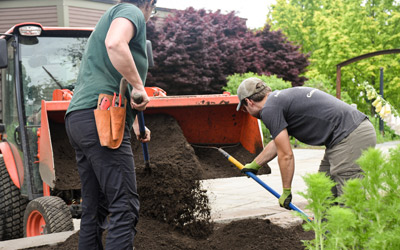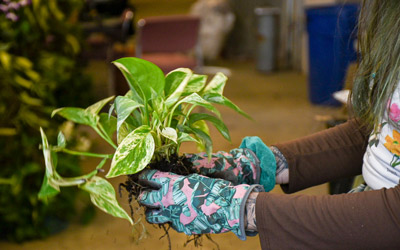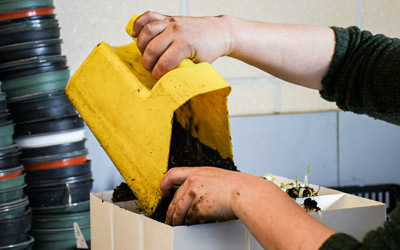Nurturing Healthy Soil
Healthy soil is key to the success of any garden, but did you know healthy soil, alive with microorganisms, can also capture carbon dioxide from the atmosphere helping to mitigate climate change? The horticulture team employs practices that promote healthy soil, like using plants as living mulches, limiting use of chemical fertilizers, and spreading locally sourced goat manure throughout our gardens.
Managing the Soil
The world of soil and fertilizer may not be interesting to many people, but at a botanic garden soil is one of the most vital resources. Healthy soils hold onto carbon by sequestering it through communities of microorganisms. To help nurture a strong soil microbiome, we test the soil and apply the necessary fertilizers. We use organic mulches and leaf litter, most of which is made on-site. All organic waste is collected and added to compost piles. The compost, located in giant storage areas behind the horticulture barn, is turned periodically, then used throughout the year. The formal gardens receive composted goat manure purchased from a local farm.
In our conservatories we’ve also begun exploring organic fertilizers and have adopted the use of peat-free soils. Peat, high carbon accumulations of partially decayed organic matter, forms naturally in bogs and peatlands. When peat is unearthed for use in potting soils, sequestered carbon is released into the atmosphere where it contributes to climate change.
Building the Climate Garden
Methods of modern agriculture emit large amounts of greenhouse gases, but how we grow our food doesn’t have to contribute to climate change. The Climate Garden, a hands-on, youth-oriented garden, opened in the summer of 2023, demonstrates agriculture techniques for a more sustainable future. These techniques, employed on a scale for the home gardener, have the power to draw carbon from the atmosphere, restore healthy soils, support biodiversity, and help create a more sustainable food system. Throughout the year, the garden hosts drop-in activities and educational programs. In each carefully designed garden bed, visitors can explore crop plants celebrated for their drought tolerance, nitrogen fixing ability, importance as cover crops, contribution to pollinator habitat, and more.
Each day, the Garden continues to make strides toward becoming more sustainable. Click here to learn about our Sustainable Initiatives.




